news Japanese consumer electronics manufacturer Toshiba has launched three new tablets in Australia, all running the latest version 4.0 (Ice Cream Sandwich) of Google’s Android platform and in sizes ranging from 7.7″ to a large 13.3″.
The company has over the past year or so launched quite a few Android tablet models locally, including a model which it described as the world’s thinnest and lightest tablet in January this year, and its AT100 model in June 2011. However, none are believed to have made a significant impact on the local tablet market, which remains overwhelmingly dominated by Apple’s iPad.
The first of the three new models is the AT270, a 7.7″ tablet which is 7.8mm thick and weighs 350 grams. It is powered by a NVIDIA Tegra quad-core processor and comes with 1GB of RAM, 16GB of storage space, a screen resolution of 1280×800, eight hours of battery life and a five megapixel rear and two megapixel front camera. It also comes with a micro-SD card slot and a micro-USB port. “The super slim 7.7” pocket-sized AT270 brings games, movies and photos to life in the palm of your hand, providing a vivid viewing experience on the go,” said Toshiba. The AT270 has a recommended retail price of $539.
The next model up in terms of size, the AT300, weighs 600g, and uses what Toshiba has labelled its ‘Adaptive Display’ technology that automatically adjusts brightness to suit changing lighting conditions during the day or night, leading to better picture quality. This model comes with a 10.1″ screen, the same NVIDIA CPU, 1GB of memory, 16GB of storage space, a 1280×800 resolution and the same eight hours of battery life, five megapixel rear and two megapixel front camera, micro-SD card slot and a micro-USB port. It also comes with a micro-HDMI port. It will also sell for an RRP of $539.
The largest of the three, the AT330, will sell for a little more, $699, and comes with a 13.3″ touchscreen running at a resolution of 1600×900. It similarly has a quad-core CPU, 1GB of memory and 16GB of storage, but it weighs quite a bit more, at 998 grams, and is quite a bit larger physical, at 343.77mm x 211.23mm x 9.81mm.
Like the AT300, the AT330 comes with five megapixel rear and two megapixel front camera, micro-SD card slot and a micro-USB port, as well as a micro-HDMI port. All three tablets will be available locally in late June.
“The three new tablets feature elegant yet robust aluminium shells and scratch-resistant Corning Gorilla Glass displays, making them not only stylish but also durable,” said Toshiba. ” In-built stereo speakers with exclusive sound enhancements by Toshiba and SRS Labs provide a quality audio experience, while Wi-Fi, Bluetooth® and multiple-ports ensure maximum connectivity.”
opinion/analysis
In my opinion, none of these tablets will sell well in Australia. Although the devices represent a significant hardware and software upgrade compared with Toshiba’s previous line-up, in general their design appears mediocre and uninspired.
I don’t think most of the Android vendors understand yet that win significant market share in Australia, they need to either offer something better than the iPad, which is unlikely — although Amazon has given it a go content-wise with its Kindle line — or offer similar quality products at a cheaper price. Offering inferior products at the same price is not a good market strategy. Nevertheless, we’ll try to get the new Toshiba line-up into Delimiter HQ for reviews; they may surprise us yet.
Image credit: Toshiba

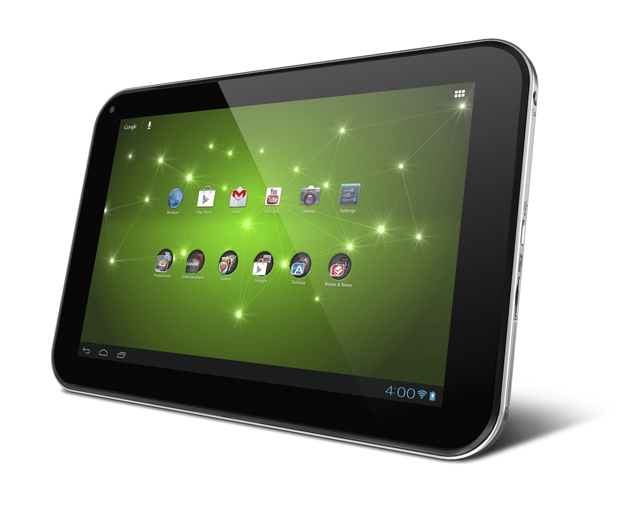
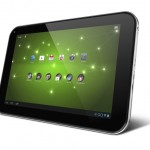
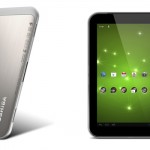
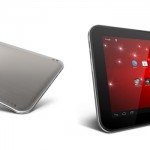
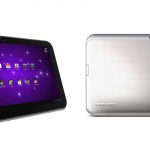
I don’t think most of the Android vendors understand yet that win significant market share in Australia, they need to either offer something better than the iPad
Maybe they just hope to be profitable & pay their bills and labour? Not every company is out to destroy all competition no matter how profitable they are. They very likely know their place in the scheme of things or they wouldn’t have produced the tablet in the first place.
Offering inferior products at the same price is not a good market strategy.
Why is it necessarily ‘inferior’? It has a better cpu, the same RAM, comes in choice of different sizes (does iPad come in 7.7 or 13.3?). It has landscape orientation for video. It has multitude of output ports and input slots. It runs an open OS. I would say it is ‘different’, not necessarily ‘inferior’.
I will give you ‘inferior’ on the screen resolution. You can watch your cropped 16:9 movies in 4:3 in glorious high-density.
Take out the italics in that second paragraph .. :)
Why is it necessarily ‘inferior’?
Much of this comes down the operating system and build quality. I’ve tested a variety of Android-based tablets and the operating systems (Honeycomb or Ice Cream Sandwich) just feels a lot less polished than iOS. On the smartphone Android has definitely caught up and even exceeded iOS, but not on the tablet just yet.
With respect to build quality, Samsung and Amazon are really the only vendors with build quality more or less equal to the iPad. The materials and construction the other vendors are using really do not stack up yet. I don’t expect these Toshiba tablets to be any different; although as mentioned, I will try to get them in for review.
Really liking my Aldi $250 tablet. Sometimes the CPU could be a little better and get the original Android 3 calendar back and fix the youtube and facebook apps, but other than that it is a brilliant tablet.
When will vendors learn, $250 price point and you’ll own the tablet market, people will buy them by the truck load.
+1
This is definitely what we saw with the made rush to buy the obsolete HP TouchPads.
I have an iPad2. It’s a lovely piece of kit physically, but the software seems crippled. For example, I have a large music collection in flac and ogg formats on my computer and in a USB hard drive, but there’s no convenient way to play them and no USB socket to facilitate file transfer. I don’t run Windows, or a Mac, so I don’t have iTunes. I’m certainly not going to join the Apple eco-system and re-buy all of my entertainment. I get far more joy from my Android STB, which easily plays my videos and music from wherever I load them and in whatever format I choose.
Nevertheless, the iPad is very good for a small group of activities. It should cost much less, in view of its limited capabilities. Actually, I’m waiting anxiously for my cheap Raspberry Pi and hoping to put it in a mobile, battery-powered box that will leave the iPad for dead.
“I don’t run Windows, or a Mac, so I don’t have iTunes.”
I don’t know what kind of PC you run, but I’m betting Linux. In this case, your statement is factually inaccurate; there are indeed ways to synch any PC — Mac, Windows or Linux, with an iPad:
https://discussions.apple.com/thread/3551237?start=0&tstart=0
I do run Linux – since the late 90s. Debian sid and KDE.
I did a brief search, but gave up too soon. I’d still like a few standard connectors, though.
Thanks. I’ll follow your lead.
You’re running Debian sid and you’re complaining that your iPad doesn’t sync.
Give me a break.
lmao
You don’t have to be a genius to run Debian sid and KDE, but there’s also a definite learning curve with a new iPad, if you want more than a final common pathway for contributing to iTunes and the app store.
I agree – I should have searched more extensively, but I assumed that a solution would be quick and easy to find, with so many iPads out in the wild. Perhaps the problem is that there aren’t a lot of iPad owners who already own a huge collection of classical music in flac and ogg files (ripped from my vinyl and CD collections) and videos in various codecs that they would like to transfer easily and play on it.
For what it was designed for, the iPad is excellent, but my comment related to its inflexibility. Nevertheless, I think I can make it work for me, thanks to help from people like you. And I appreciate your help.
Comments are closed.